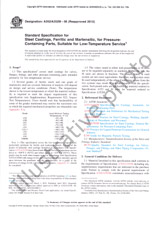We need your consent to use the individual data so that you can see information about your interests, among other things. Click "OK" to give your consent.
ASTM F2732-16
Standard Practice for Determining the Temperature Ratings for Cold Weather Protective Clothing
Translate name
STANDARD published on 1.10.2016
The information about the standard:
Designation standards: ASTM F2732-16
Note: WITHDRAWN
Publication date standards: 1.10.2016
SKU: NS-666154
The number of pages: 7
Approximate weight : 21 g (0.05 lbs)
Country: American technical standard
Category: Technical standards ASTM
The category - similar standards:
Annotation of standard text ASTM F2732-16 :
Keywords:
clothing insulation, outdoor clothing, temperature rating, thermal insulation, thermal manikin,, ICS Number Code 61.020 (Clothes)
Additional information
| Significance and Use | ||||
|
4.1 This practice is used to measure the insulation provided by different cold weather clothing systems using a heated manikin (see Test Method F1291) and to predict the temperature rating for comfort at two activity levels using whole body heat loss models. 4.1.1 The temperature rating is for an ensemble—not an individual garment. However, manufacturers want to label cold weather garments with a temperature rating to help consumers select the product that will best meet their needs. Therefore, the standard is limited to garments that cover a substantial amount of body surface area such as jackets, coats, and insulated pants, coveralls, or snow suits. The temperature ratings of head wear, footwear, and hand wear cannot be determined with this practice. 4.1.2 The temperature predictions determined by this standard practice are for adults only. The physiology of children is significantly different from that of adults, so a modified heat loss model needs to be used to predict the comfort of children wearing outdoor clothing.5 4.1.3 The temperature ratings determined by this standard practice and listed on garment labels are only guidelines for comfort and will be affected by the garments consumers wear with them, their activity level during wear, and individual differences in the physiological characteristics of people (for example, gender, age, body mass, etc.). |
||||
| 1. Scope | ||||
|
1.1 This standard practice covers the determination of the temperature rating of cold weather protective clothing ensembles. It involves measuring the thermal resistance (insulation) value of a clothing ensemble with a heated manikin in accordance with Test Method F1291 and using a heat loss model to predict the lowest environmental temperature for comfort. 1.2 The predictive model used in this standard estimates the evaporative heat loss from a person wearing cold weather clothing as opposed to measuring the evaporative resistance on a sweating manikin. If a person is active and gets overheated in a cold environment, he/she is usually able to adjust the garments in order to dissipate excess heat. 1.3 The temperature ratings estimated by this standard practice are guidelines for thermal comfort that are designed to protect people from hypothermia when wearing cold weather protective garments. However, localized cooling, discomfort, and even frostbite could still occur at extremely low temperatures because clothing insulation is not evenly distributed over the body surface. In addition, some body parts (for example, ears, fingers, toes) have a high surface area relative to their mass, and consequently lose heat at a faster rate than other parts of the body. 1.4 This standard does not purport to address all of the safety concerns, if any, associated with its use. It is the responsibility of the user of this standard to establish appropriate safety and health practices and determine the applicability of regulatory limitations prior to use. |
||||
| 2. Referenced Documents | ||||
|
We recommend:
Technical standards updating
Do you want to make sure you use only the valid technical standards?
We can offer you a solution which will provide you a monthly overview concerning the updating of standards which you use.
Would you like to know more? Look at this page.




 Cookies
Cookies
